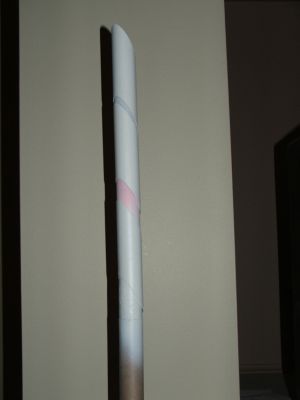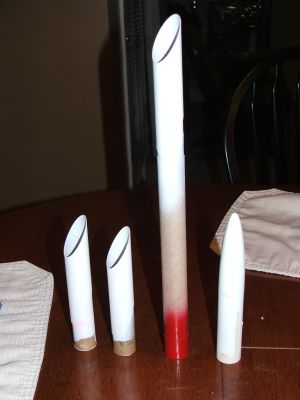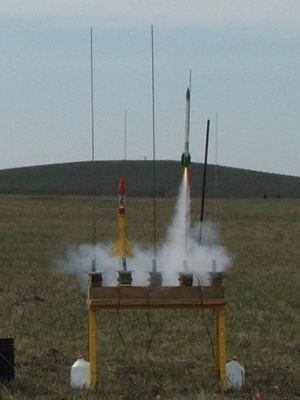Balsa Machining Service F.S.I. Viking (Clone of the Month)
Balsa Machining Service - F.S.I. Viking {Kit}
Contributed by Bill Eichelberger
| Construction Rating: | starstarstarstarstar |
| Flight Rating: | starstarstarstarstar |
| Overall Rating: | starstarstarstarstar |
| Manufacturer: | Balsa Machining Service  |

Brief:
The Viking is the initial monthly offering (hopefully to be followed by more) by Balsa Machining Services. Originally produced by Flight Systems, Incorporated, the Viking is a unique looking tube finned, minimum diameter bird with what should be the potential for "outasight" flights (to borrow an old Estes phrase).
Construction:
The parts list:
- 2 T50H body tubes 9" length
- 3 bias cut T50H tube fins
- T50H stabilizer spacer
- T50 equivalent tube coupler
- BNC50X balsa nose cone
- 1/4" eye bolt
- EB24-P engine block
- 36" length Kevlar
- 18" length of 1/8" sewing elastic
Bill used a copy of the original instructions with this kit. They weren't overly descriptive, but anyone with a few birds under their belt will have no trouble with the construction. The two halves of the main body tube are attached with the coupler and wood glue. I then tied the length of Kevlar around the engine block and secured it with wood glue, then glued the engine block into the lower section of the main body tube. The giant screw eye was epoxied into the nose cone and attached with a large snap swivel. At this point the rocket was complete except for attaching the tube fins, which was done with epoxy after all painting was finished for reasons of masking impossibility. The method for attaching the tube fins is fairly simple. An extra piece of body tube the same diameter as the tube fins is provided and the first fin is carefully epoxied into place so that the foremost tip of the fin is flat against the main body tube. Once this tube dries the extra piece of tubing is secured in place with masking tape and the next tube fin is attached so that all three pieces of tube are flush with each other. The second tube fin is then epoxied into place and the process is then repeated for the final tube fin.


Finishing:
The normal process of thinned Elmer's Fill 'n' Finish and sanding was used to kill off the grain in the balsa nose cone, the spirals in the tubes and the seam in between the two body tube halves. As usual, I went with the package art when painting, which is in this case green. I'm not normally a fan of green and more than likely would have opted for white with red or blue accents, but the decals came in green so I went with the flow. I couldn't figure a way to paint the tube fins after they'd been attached to the main body tube, so I painted all of the components before final assembly. For the nose cone and tube fins I used a Valspar green that matched up well with the green on the decal and Valspar gloss white for the main body tube. Decals were coated with Testor's Decal Bonder before they were applied and they were great to work with. The final product looks like something that I'll want to coat with a clear to protect it. It really turned out great.
Construction Rating: 5 out of 5
Flight and Recovery:
First and only flight to date was at my first QUARK launch of 2008 (and first in almost six months). I'd bought some C11-7 and D12-7 motors for the launch anticipating several flights, but I'd underestimated the winds for the day. The Viking on a C11-7 was the third flight of the day and everything about the flight impressed. It left the pad and never seemed to waver on its arrow straight ascent. It was at ejection that the fun started. I had a small 10" chute on it and at first it looked like it might be an easy recovery walk, but then it started hanging. I watched as it crossed the park heading for the Kite Fest. From the flight line, touchdown looked like it was right in the middle of the kite flyers. I took off after it, careful to keep in line with the landmark that I'd picked out during the descent. As I neared the soccer field where many of the big kites were flying, I noticed a small, clear parachute blowing around on the ground. It seemed closer than I was expecting, but there was a lady there waving at me and standing guard over the Viking. She had as many questions about rocketry as I had about the kites. (Her husband was flying a $1200 USED kite just behind us, and it was true that some of the big ones could indeed cost up to $18,000.) Impressive flight, but I knew I'd never have the guts to try it on a D12-7 that day.


Flight Rating: 5 out of 5
Summary:
PROs: Clone of the Month? How cool is that? An FSI clone! How cool is that? The Viking is a great looking bird, and at $6, you could buy a bunch of them. (And I should have. I need another one to build with an E mount.) Performance is impressive on a C11 and should really scream on a D12.
CONs: There wasn't a KOTM for March, but I'm still holding out hope for April.
Overall Rating: 5 out of 5
Other Reviews
- Balsa Machining Service F.S.I. Viking (Clone of the Month) By Chan Stevens (August 23, 2008)
Brief: This was the first of BMS's recent Clone of the Month program offerings and is a reproduction, slightly upscaled, of the 1971 Viking I produced by Flight Systems Inc. There were 4 versions of the Viking that year with minor differences in length and tube/fin styling. This version uses purely tube fins for stability with none of the fin tabs or braces used in other versions. ...
 |
 |
Flights
Sponsored Ads
 |
 |










![Apple Watch Ultra [GPS + Cellular 49mm] Titanium Case with Midnight Ocean Band, One Size (Renewed Premium) Apple Watch Ultra [GPS + Cellular 49mm] Titanium Case with Midnight Ocean Band, One Size (Renewed Premium)](https://m.media-amazon.com/images/I/41NQgyV24pL._SL500_.jpg)
